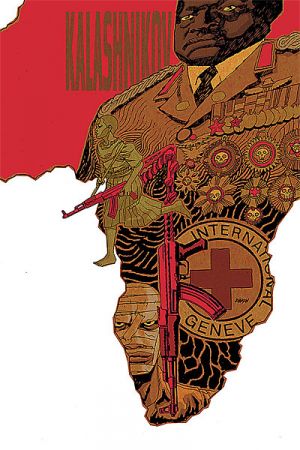- Comics
- Comics Reviews
- Manga
- Comics Reviews
- European Comics
- News
- Comics News
- Press Releases
- Columns
- Spotlight
- Digital Comics
- Webcomics
- Cult Favorite
- Back Issues
- Webcomics
- Movies
- Toys
- Store
- More
- About
By Andy Frisk
July 24, 2010 - 23:03
“If you want to keep the fascists off the streets of Moscow, if you want to save thousands of Russian lives…if Stavka wants to end this violence…then we’re going to need the right gun.”
-Mikhail Kalashnikov
Unknown Solider #21
“I would prefer to have invented…a lawnmower.”
-Mikhail Kalashnikov
In yet another powerful issue of one of the most important comic book series in publication, series writer Joshua Dysart delivers a tale that follows the life of a personified AK-47 assault rifle as it changes hands from one owner to another through the years. “A Gun in Africa” not only continues Dysart’s stark and at times horrifying trek through the bloody ethnic, economic, ideological, and tyrannical wars that continue to scar the continent, it does so uniquely and poignantly. This time it is a very different weapon of destruction that narrates the tale (usually the Unknown Solider does the narrating). The AK-47 itself is the narrator. It relates its time spent in the hands of a Marxist Cuban soldier from Havana as he fights in support of pro-Marxist Ethiopians against Somali separatists in 1976 through the time it ends up in the hands of one of Joseph Kony’s Lord’s Resistance Army (LRA) child soldier’s hands who is aiming it at Dysart’s Unknown Solider in 2003.
 |
Through the years Dysart’s AK-47 passes through the hands of ivory poachers, a peaceful Ugandan farmer, and a member of the Ugandan Karamojong tribe who is a cattle rustler and raider. Throughout its several decades long journey, Dysart’s AK-47 witnesses the rise of ivory poaching, Idi Amin Dada, and the LRA. Death and destruction are its constant companions, but interestingly enough the time the AK-47 spends with the peaceful Ugandan farmer is the gun’s “purest expression of my father’s (Kalashnikov) intent.”
“A Gun in Africa” opens with a short introduction to the AK-47’s inventor, Mikhail Kalashnikov. After witnessing the wholesale slaughter of Russian troops by superiorly armed Nazi soldiers in Bryansk during World War II, Kalashnikov comes up with the design for the AK-47 with the desire to save Russians from the fascists. Quickly though, as Dysart’s tale so artfully relates, Kalashnikov’s invention becomes the scourge of many innocent civilians and animals (through poaching) over the years. So widespread and lethal is the AK-47, with its simple and long lasting design (Dysart tells us that the Ak-47’s average life span is 20 to 30 years), that Kalashnikov remarked later in life, “I would prefer to have invented…a lawnmower.” The weapon he designed as a defense against tyranny became the chosen weapon of tyrants. Dysart’s condensed history of decades of horror in Africa which is told alongside the history of the most mass produced and abused weapon of war in history is simply masterful. Unknown Soldier should be required reading for every student of the history, political science, and tribulations of Africa, the human condition, and of how to create the most powerful sequential art possible.
Long term comic writer and artist Rich Veitch (Swamp Thing, ArmyatLove) brings his graphically powerful style to bear as guest artist this issue. He accurately and at times painfully, as is his style, recreates the detailed mechanics of the AK-47 and the violent death that it brings. He also captures the look of various African tribes and tyrants like Idi Amin accurately and strikingly. His artwork is graphically violent, but potent, much like Dysart’s tale is.
If you haven’t been reading Unknown Soldier (you should be), “A Gun in Africa” is the perfect jumping on point. Joshua Dysart’s powerful meditation on the human rights atrocities and daily battles in one of the most overlooked yet war torn areas of the world is easily one of the most important sequential art series ever.
Rating: 10 /10